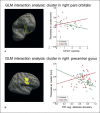Altered Brain Structure-Function Relationships Underlie Executive Dysfunction in 22q11.2 Deletion Syndrome
- PMID: 27606315
- PMCID: PMC4996003
- DOI: 10.1159/000441979
Altered Brain Structure-Function Relationships Underlie Executive Dysfunction in 22q11.2 Deletion Syndrome
Abstract
22q11.2 deletion syndrome (22q11DS) is a neurogenetic disorder associated with elevated rates of developmental neuropsychiatric disorders and impaired executive function (EF). Disrupted brain structure-function relationships may underlie EF deficits in 22q11DS. We administered the Behavior Rating Inventory of Executive Function (BRIEF) to assess real-world EF in patients with 22q11DS and matched controls (n = 86; age 6-17 years), along with cognitive measures that tap behavioral regulation and metacognition aspects of EF. Using FreeSurfer's whole-brain vertex cortical thickness pipeline, we investigated brain structure-EF relationships in patients with 22q11DS and controls. Behaviorally, patients with 22q11DS were impaired on multiple EF measures. Right orbitofrontal cortical thickness showed a differential relationship between real-world EF in patients with 22q11DS and controls. We also observed a group difference in the relationship between behavioral regulation and metacognition measures with thickness of ventral and dorsolateral prefrontal regions, respectively. Our findings suggest that executive dysfunction characteristic of 22q11DS is underscored by altered prefrontal cortical structure.
Keywords: Cognitive function; Copy number variation; Dopamine; Magnetic resonance imaging; Neurodevelopment; Neurogenetics; Prefrontal cortex.
Figures



References
-
- Edelmann L, Pandita RK, Spiteri E, Funke B, Goldberg R, Palanisamy N, et al. A common molecular basis for rearrangement disorders on chromosome 22q11. Hum Mol Genet. 1999;8:1157–1167. - PubMed
-
- Shashi V, Veerapandiyan A, Schoch K, Kwapil T, Keshavan M, Ip E, et al. Social skills and associated psychopathology in children with chromosome 22q11.2 deletion syndrome: implications for interventions. J Intellect Disabil Res. 2011;56:865–878. - PubMed
-
- Murphy KC, Jones LA, Owen MJ. High rates of schizophrenia in adults with velo-cardio-facial syndrome. Arch Gen Psychiatry. 1999;56:940–945. - PubMed
Grants and funding
LinkOut - more resources
Full Text Sources
Other Literature Sources
Miscellaneous

